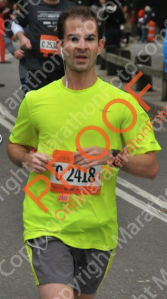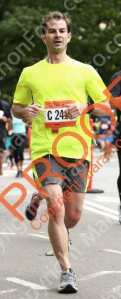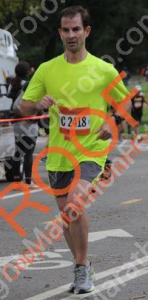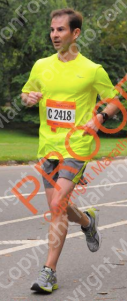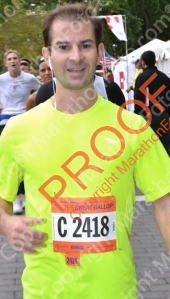With warnings that a polar vortex would plunge the east coast into a President’s Day weekend cold spell, I was comfortably certain that my quick escape to Southern California would yield a polar opposite forecast. That surety gave way to reality, as even the most experienced marathoners struggled during Saturday’s Olympic Trials, the warmest on record. To successfully complete my Sunday trek to Santa Monica, it was obvious this marathon mortal would need to adopt a cautiously conservative approach.
My most recent marathon, New York City this past November, tested me in ways I hadn’t expected. I was still scarred by those final miles, where a failure to adapt my hydration and pacing strategy to the conditions had dealt a crushing blow to my confidence. These memories, still vivid and raw, coupled with a shorter, 12-week training regimen had led me to eschew setting any time goals. Instead, I aimed to focus on adapting to the warmer conditions while reclaiming my mental fortitude.
 It was just a short shuttle bus ride from downtown LA to the starting line at Dodger Stadium. The pre-dawn air was comfortably chilly, and I savored the cool temperature that I knew would rise steadily once the horizon gave way to a beaming sun. I made may way into the stadium, which served as a temporary staging ground. Though I’d seen countless views of Dodger Stadium on television, this was my first time inside the historic stadium. I marveled at how cool it was to be able to freely meandering around. As a first time visitor to Los Angeles, I couldn’t wait to see so many of the city’s landmarks that I’d only admired previously on screen. In my mind, the TMZ tour bus didn’t have anything on today’s stadium to the sea course.
It was just a short shuttle bus ride from downtown LA to the starting line at Dodger Stadium. The pre-dawn air was comfortably chilly, and I savored the cool temperature that I knew would rise steadily once the horizon gave way to a beaming sun. I made may way into the stadium, which served as a temporary staging ground. Though I’d seen countless views of Dodger Stadium on television, this was my first time inside the historic stadium. I marveled at how cool it was to be able to freely meandering around. As a first time visitor to Los Angeles, I couldn’t wait to see so many of the city’s landmarks that I’d only admired previously on screen. In my mind, the TMZ tour bus didn’t have anything on today’s stadium to the sea course.
Soon enough, it was time to check my baggage and head to the corrals adjacent to the stadium, just beyond the walls of the outfield. As the skies began to give way to the day’s light, my anticipation was building.
 For many events, great care is given to the actual start to tie into a city theme. In New York, it’s the firing of a howitzer cannon, followed by a rendition of Sinatra’s New York, New York. New Jersey’s start occurs outside a horse track, so a call to post bugle is apropos. In LA, the signal to start was given by the wailing of a siren, which I found reminiscent of a slow speed car chase. I doubt that’s the association they were going for, but I found it fitting, nonetheless.
For many events, great care is given to the actual start to tie into a city theme. In New York, it’s the firing of a howitzer cannon, followed by a rendition of Sinatra’s New York, New York. New Jersey’s start occurs outside a horse track, so a call to post bugle is apropos. In LA, the signal to start was given by the wailing of a siren, which I found reminiscent of a slow speed car chase. I doubt that’s the association they were going for, but I found it fitting, nonetheless.
After clearing the start line, the course almost immediately began an uphill climb, followed by a sustained downhill. Throughout, I focused on controlling my pace as I headed toward the next landmark on the day’s sightseeing itinerary, the Chinatown Dragon Gate. As I passed under, I longed to capture these sights for posterity. For the first of many times this day, I wished the Google Glass had made it to market. Just two miles in, I already knew it was going to be a thrilling day.
 From Chinatown, we headed toward some familiar downtown roads. As wound our way toward Grant Park, the meet-up site of Friday’s Ryan Hall shakeout run, the crowds were mostly sparse, but those who did gather were evidently deeply concerned about our collective future. As runners, its not uncommon to be conscious about our soles. If our soles are too worn, injuries can arise. Conversely, if our soles aren’t broken in, and blisters can confound. But whether peering over an overpass, under a tree on the left or alongside a building on the right, a remarkable number of spectators were resolutely holding signs scribbled with dire warnings- for our souls. I had no idea marathoners were such a sinful group, but apparently we were in immediate need of repentance. Indeed, the eclectic spirit of the City of Angels was alive and well.
From Chinatown, we headed toward some familiar downtown roads. As wound our way toward Grant Park, the meet-up site of Friday’s Ryan Hall shakeout run, the crowds were mostly sparse, but those who did gather were evidently deeply concerned about our collective future. As runners, its not uncommon to be conscious about our soles. If our soles are too worn, injuries can arise. Conversely, if our soles aren’t broken in, and blisters can confound. But whether peering over an overpass, under a tree on the left or alongside a building on the right, a remarkable number of spectators were resolutely holding signs scribbled with dire warnings- for our souls. I had no idea marathoners were such a sinful group, but apparently we were in immediate need of repentance. Indeed, the eclectic spirit of the City of Angels was alive and well.
Whether training over the Queensboro, Brooklyn, Manhattan, or even the Triboro bridge, or routinely climbing the Cat or Harlem hills, inclines are part and parcel of New York City running. That said, the ridiculously steep multi-block (I lost count) climb through the downtown portion of the course was no joke. Focusing on effort, I felt my pace increasing, commensurate with the grade. My mind drifted as I eavesdropped on two locals behind me commiserating about their most recent marathon experience. As they regaled each other with war stories over the difficulties of New York’s bridges, I took a deep breath and pushed forward. After all, I was a New York runner. This, like those bridges, was merely breakfast.
 Finally heading out of downtown I looked forward to arriving in Los Feliz, which, according to the official race program, was where I’d be able to see the Hollywood sign for the first time. Alas, the sign was nowhere to be seen. There were so many landmarks along this course, that their associated mile markers were a blur. Los Feliz remained elusive.
Finally heading out of downtown I looked forward to arriving in Los Feliz, which, according to the official race program, was where I’d be able to see the Hollywood sign for the first time. Alas, the sign was nowhere to be seen. There were so many landmarks along this course, that their associated mile markers were a blur. Los Feliz remained elusive.
As the day’s temperature continued to rise, I had just settled in to a comfortable pace when otherwise ordinary streets gave way to a lush greenery and a picturesque fountain. In my Los Feliz haste, I’d somehow forgotten that I’d first pass Echo Park.
When it comes to leisure reading, I’ve always been a fan of mystery and legal thrillers. LA-based writer Michael Connelly is one of my go-to authors, and one of his first books I read was titled, Echo Park. I had envisioned Echo Park as a crime-ridden dumping ground for bodies. As I ran by, I realized that presumption was misplaced. The park looked absolutely stunning. I realized if I’d likely fallen into the same trap as longtime Law and Order viewers, who probably think analogously of New York’s Central Park.
 Nearing the 7 mile mark, I maintained my position alongside the lefthand side of the course. Hydration would be key today, and I wanted to make sure I was always inline to easily grab a cup of fluid from a volunteer’s outstretched hands. Having learned my lesson from last fall’s New York outing, once I’d secured a cup I’d take more than a quick gulp. Today, I’d gulp and continue on, before finally draining the liquid gold.
Nearing the 7 mile mark, I maintained my position alongside the lefthand side of the course. Hydration would be key today, and I wanted to make sure I was always inline to easily grab a cup of fluid from a volunteer’s outstretched hands. Having learned my lesson from last fall’s New York outing, once I’d secured a cup I’d take more than a quick gulp. Today, I’d gulp and continue on, before finally draining the liquid gold.
I may not remember the exact time or milage moment, but I will never forget looking up and to my right and seeing those nine white letters standing upright along the hill in all their glorious wonder: Hollywood. As quintessential as the Empire State Building, it was the single sight I’d been visualizing for weeks in all its glory! From that point on, smile lines would be permanently etched on my face. I was running in the moment, and having the time of my life doing so.
For much of the course, spectator masses would appear in pockets. But whether the roadside was thinly or densely populated, their support was buoyant. Makeshift aid stations appeared as storeowners unloaded pallets of bottled water, while residents poured bottled water in cups. Tubs of orange slices were handed out by various running clubs, while members of various community organizations armed with spray bottles spritzed momentary relief from the heat. It’s one thing to prepare a homemade sign to encourage an individual marathoner. But the the forethought and genuine care of these most meaningful gestures of encouragement were quite another. I was both appreciative and awestruck.
 With its namesake sign serving as a beacon, I was ready to make my way into Hollywood. Running down Hollywood Boulevard, just beyond the spectators lining the side of the street, I began to make out etchings in the sidewalk. Their star shapes were instantly recognizable, and I could feel my pace quicken with excitement. I consciously eased up, determined to fully take in the atmosphere. Off to the right, was a stage, were a couple, one clad in running clothes, beginning to take their marriage vows. I’d remembered reading that on this Valentine’s Day, a makeshift chapel was available to couples ready to tie the knot. The effort was a publicity stunt designed to promote the upcoming release of the sequel to “A Big Fat Greek Wedding.” Of course, this was Hollywood, after all.
With its namesake sign serving as a beacon, I was ready to make my way into Hollywood. Running down Hollywood Boulevard, just beyond the spectators lining the side of the street, I began to make out etchings in the sidewalk. Their star shapes were instantly recognizable, and I could feel my pace quicken with excitement. I consciously eased up, determined to fully take in the atmosphere. Off to the right, was a stage, were a couple, one clad in running clothes, beginning to take their marriage vows. I’d remembered reading that on this Valentine’s Day, a makeshift chapel was available to couples ready to tie the knot. The effort was a publicity stunt designed to promote the upcoming release of the sequel to “A Big Fat Greek Wedding.” Of course, this was Hollywood, after all.
Continuing on, there was the Dolby Theater. Where were the American Idol contestants, I wondered. Had I missed the famed Chinese Theater? Nope. There it is. I’m not sure I’d ever had so much fun running. When I usually take that dreaded gander at my race photos, I’m normally wearing a focused expression. On this day, however, I have photographic proof of my miles-long cheek to cheek grin. The elation was as demonstrably obvious outward as it was felt inward.
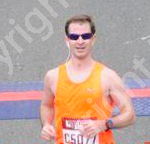 I was on such a high that I didn’t notice leaving Hollywood and entering West Hollywood. But as I made my way through West Hollywood, I did notice the rising temperature. The fluid stations stretched a good distance, and I began taking both gatorade and water. By mile 14, I faced my first bout of discomfort. Prior to the shakeout run, Ryan Hall had provided attendees with his anecdote for when difficulty seeped in: gratitude. So rather than turning up the volume of my music, I did the opposite. I turned it down and started thinking about how thankful I was. My appreciation to be running this race. My gratitude for the ability to run. My thankfulness to the support of my family’s encouragement. In no time, I was back on track.
I was on such a high that I didn’t notice leaving Hollywood and entering West Hollywood. But as I made my way through West Hollywood, I did notice the rising temperature. The fluid stations stretched a good distance, and I began taking both gatorade and water. By mile 14, I faced my first bout of discomfort. Prior to the shakeout run, Ryan Hall had provided attendees with his anecdote for when difficulty seeped in: gratitude. So rather than turning up the volume of my music, I did the opposite. I turned it down and started thinking about how thankful I was. My appreciation to be running this race. My gratitude for the ability to run. My thankfulness to the support of my family’s encouragement. In no time, I was back on track.
By around mile 17, the loud Hollywood sign gave way to a more understated, yet iconic brown and yellow sign. I was entering Beverly. Hills, that is. Swimming pools, movie stars. Though with my bright orange singlet and shorts, I was feeling more like Jed Clampett than Carlton Banks. As I turned the corner onto Rodeo Drive, I couldn’t help but notice that one spectator sign that is a marathon mainstay was conspicuously absent: run like you stole something. I guess they figured this wasn’t the street to plant that sort of idea.
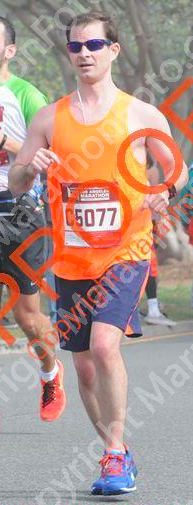 As Beverly Hills turned into Brentwood, the miles were accumulating. The sun was also in full force. So far, my hydration approach was working, but I wasn’t ready to let my guard down yet. While I have always abided by the admonition to never try anything new on race day, I decided to make an exception.
As Beverly Hills turned into Brentwood, the miles were accumulating. The sun was also in full force. So far, my hydration approach was working, but I wasn’t ready to let my guard down yet. While I have always abided by the admonition to never try anything new on race day, I decided to make an exception.
After downing a cup of gatorade at the 18 mile fluid station, I grabbed a water. I took a quick gulp, then brought the cup over my head and poured the remaining liquid onto the back of my neck. As the water rushed down my back I instantly felt a jolt of alertness. The pour not only had a cooling effect, but also a rejuvenating impact. Where I had begun to feel a bit sluggish, I was now feeling fresh. It’s not a novel trick, I’d seen others do it countless times. Why hadn’t I? I did the same at mile 19. And mile 20. and mile 21. Like watering a blooming plant, each pour had an invigorating result.
Passing the 20 mile mark, the fabled point where the marathon begins, the elevation began to climb again. I again channeled my thoughts, focusing on gratitude. Yes, my legs were tired, but I wasn’t dehydrated. And mentally, thanks to Hall’s tips, I was in fine shape. I remained in the present and continued on, putting one foot in front of the other.
 In the later stages of a marathon, a mantra can be a helpful tool to push through the final miles. “Pain is temporary, pride is forever.” “I got this.” I’ve successfully used each of those before. On this day, I turned to Sir Isaac Newton for inspiration, “What goes up must come down.” Knowing that by mile 23 the course would yield a much deserved downhill, I adopted Newton’s scientific observations for solace during the challenging late terrain.
In the later stages of a marathon, a mantra can be a helpful tool to push through the final miles. “Pain is temporary, pride is forever.” “I got this.” I’ve successfully used each of those before. On this day, I turned to Sir Isaac Newton for inspiration, “What goes up must come down.” Knowing that by mile 23 the course would yield a much deserved downhill, I adopted Newton’s scientific observations for solace during the challenging late terrain.
Once I finally began the course’s final descent, I was euphoric. I honestly felt the best I had in the closing miles of any marathon to date. As the elevation lowered, fog enveloped the sun and the temperature seemed to drop with each step. As excitement and gravity took over,  I let my legs take control. When the terrain eventually leveled out the air was thick with a soupy fog. I’m sure the sea was around, somewhere, I just couldn’t see it. I wasn’t sure how much longer till the finish, but I knew it was drawing nearer. Then, just ahead and seemingly out of nowhere, it appeared.
I let my legs take control. When the terrain eventually leveled out the air was thick with a soupy fog. I’m sure the sea was around, somewhere, I just couldn’t see it. I wasn’t sure how much longer till the finish, but I knew it was drawing nearer. Then, just ahead and seemingly out of nowhere, it appeared.
3:58:21. Not my fastest marathon, but not my slowest. But I’d managed the heat, maintained my mental wits, paced well, hydrated properly, finished strong, and most importantly, savored the sights of LA. I could not have asked for better, and I was elated.
Oscar winner John Huston may not have been speaking about the LA Marathon when he observed, “Hollywood has always been a cage…a cage to catch our dreams,” but he might as well have. Coupled with the Olympic Trials, I’m not sure I’ll ever be able to exceed the high expectations set by this runcation.
 Distance running is a physically tiring, limits testing and mentally challenging endeavor that forces its participants to reach beyond their comfort zones and endure. As Jen A. Miller’s Running: A Love Story affirms, running is also a sport whose lessons are measured by far more than just podium placements or finish times.
Distance running is a physically tiring, limits testing and mentally challenging endeavor that forces its participants to reach beyond their comfort zones and endure. As Jen A. Miller’s Running: A Love Story affirms, running is also a sport whose lessons are measured by far more than just podium placements or finish times.
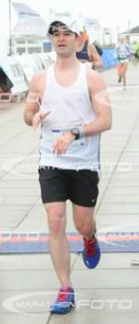 Gene Kelly may have romanticized singing in the rain as glorious, but as I recently found out, marathoning in the rain just isn’t quite the same. And based on the photographic evidence from this year’s New Jersey Marathon, the cool, wet weather didn’t fill me with a happy refrain or put a smile on my face either.
Gene Kelly may have romanticized singing in the rain as glorious, but as I recently found out, marathoning in the rain just isn’t quite the same. And based on the photographic evidence from this year’s New Jersey Marathon, the cool, wet weather didn’t fill me with a happy refrain or put a smile on my face either.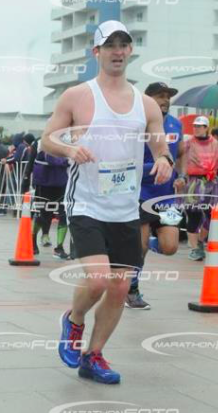 Falling approximately ten weeks after my LA Marathon racecation, I thought extending my marathon readiness would be rather simple. I’d begin with a reverse taper, run a couple 20-milers, and then enjoy a traditional taper. In a perfect world, I thought I might be able to break my standing marathon PR that I’d set on this course in 2015. Alas, the words “perfect world” should rarely, if ever, be used in the same sentence as “marathon.”
Falling approximately ten weeks after my LA Marathon racecation, I thought extending my marathon readiness would be rather simple. I’d begin with a reverse taper, run a couple 20-milers, and then enjoy a traditional taper. In a perfect world, I thought I might be able to break my standing marathon PR that I’d set on this course in 2015. Alas, the words “perfect world” should rarely, if ever, be used in the same sentence as “marathon.”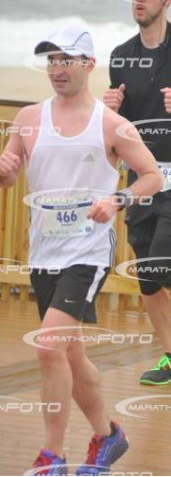 A little after 6:00 a.m,, the chartered buses pulled into the Monmouth Park parking lot. Inside the racetrack, the only wagers being placed seemed to be on when the rain would begin. Ahead of the 7:30 a.m. start I had plenty of time to collect my bib and mentally prepare for the morning ahead. Outside on the track, a few trainers were on the track exercising their horses. The working animals were simply majestic. I was transfixed, and only wished my stride could be half as efficient and effortless as the thoroughbreds before me. While I could’ve watched the training session for hours, this day’s call to post would be for runners, and that time was nearing.
A little after 6:00 a.m,, the chartered buses pulled into the Monmouth Park parking lot. Inside the racetrack, the only wagers being placed seemed to be on when the rain would begin. Ahead of the 7:30 a.m. start I had plenty of time to collect my bib and mentally prepare for the morning ahead. Outside on the track, a few trainers were on the track exercising their horses. The working animals were simply majestic. I was transfixed, and only wished my stride could be half as efficient and effortless as the thoroughbreds before me. While I could’ve watched the training session for hours, this day’s call to post would be for runners, and that time was nearing.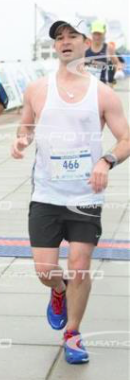 The number of runners had dwindled since turning southward. Under last year’s blue skies I had found this portion of the course rather peaceful. I’d enjoyed hearing the sound of my own feet hitting the pavement. This year’s slosh of feet against wet pavement and the accompanying puddles just weren’t as rhythmically appealing.
The number of runners had dwindled since turning southward. Under last year’s blue skies I had found this portion of the course rather peaceful. I’d enjoyed hearing the sound of my own feet hitting the pavement. This year’s slosh of feet against wet pavement and the accompanying puddles just weren’t as rhythmically appealing. Through 22 miles my Garmin showed that I had managed a pretty steady pace, hovering between the 8:40 – 8:50 mark. By mile 23, however, I was beginning slow, with the pace inching up to around 9:00. At the 22 mile point it seemed that despite the conditions and having undertrained, I could very well PR. That soon changed, however.
Through 22 miles my Garmin showed that I had managed a pretty steady pace, hovering between the 8:40 – 8:50 mark. By mile 23, however, I was beginning slow, with the pace inching up to around 9:00. At the 22 mile point it seemed that despite the conditions and having undertrained, I could very well PR. That soon changed, however. In year’s past, I’ve spent the winter months counting the days until the mid-March NYC Half. After all, the 13.1 mile trek from Central Park to Wall Street is as energetic as it is iconic. But with a February marathon already under my belt, and another marathon on the horizon, this year’s event seemed to sneak up.
In year’s past, I’ve spent the winter months counting the days until the mid-March NYC Half. After all, the 13.1 mile trek from Central Park to Wall Street is as energetic as it is iconic. But with a February marathon already under my belt, and another marathon on the horizon, this year’s event seemed to sneak up. Four years later, about the only familiarity at the start was the sound of the hovering helicopter, providing aerial shots for those watching on television at home. Sure, the air was just as crisp, and after the fact realized I’d actually worn the same black Under Armor long sleeved top, but that’s where most of the similarities ended. The course had since been modified to allow a larger field and United Airlines had staked its claim to the race as the title sponsor.
Four years later, about the only familiarity at the start was the sound of the hovering helicopter, providing aerial shots for those watching on television at home. Sure, the air was just as crisp, and after the fact realized I’d actually worn the same black Under Armor long sleeved top, but that’s where most of the similarities ended. The course had since been modified to allow a larger field and United Airlines had staked its claim to the race as the title sponsor. The most recent half marathon I’d actually raced was October’s Grete’s Great Gallop, occurring towards the end of a focused 16-week marathon training buildup. On paper, the NYC Half course should be more favorable for faster times. But, if topography were the most determinative factor to a runner’s performance, I’d of never realized the result I had in October. For a distance runner, there are always many factors at play any time one toes the line, both physical and mental. That’s one of the reasons I truly love this sport—with so many factors to contend with on any given day, each race allows an opportunity to grow, that is, if you let it.
The most recent half marathon I’d actually raced was October’s Grete’s Great Gallop, occurring towards the end of a focused 16-week marathon training buildup. On paper, the NYC Half course should be more favorable for faster times. But, if topography were the most determinative factor to a runner’s performance, I’d of never realized the result I had in October. For a distance runner, there are always many factors at play any time one toes the line, both physical and mental. That’s one of the reasons I truly love this sport—with so many factors to contend with on any given day, each race allows an opportunity to grow, that is, if you let it. The next day, I came across an impeccably timed
The next day, I came across an impeccably timed  Since November, Tom Foreman’s My Year of Running Dangerously had occupied a prime corner of my coffee table just waiting to be read, a glaring reminder of a hectic few months. However, once I finally cracked the cover open, it barely closed until the last page had been turned.
Since November, Tom Foreman’s My Year of Running Dangerously had occupied a prime corner of my coffee table just waiting to be read, a glaring reminder of a hectic few months. However, once I finally cracked the cover open, it barely closed until the last page had been turned. It was just a short shuttle bus ride from downtown LA to the starting line at Dodger Stadium. The pre-dawn air was comfortably chilly, and I savored the cool temperature that I knew would rise steadily once the horizon gave way to a beaming sun. I made may way into the stadium, which served as a temporary staging ground. Though I’d seen countless views of Dodger Stadium on television, this was my first time inside the historic stadium. I marveled at how cool it was to be able to freely meandering around. As a first time visitor to Los Angeles, I couldn’t wait to see so many of the city’s landmarks that I’d only admired previously on screen. In my mind, the TMZ tour bus didn’t have anything on today’s stadium to the sea course.
It was just a short shuttle bus ride from downtown LA to the starting line at Dodger Stadium. The pre-dawn air was comfortably chilly, and I savored the cool temperature that I knew would rise steadily once the horizon gave way to a beaming sun. I made may way into the stadium, which served as a temporary staging ground. Though I’d seen countless views of Dodger Stadium on television, this was my first time inside the historic stadium. I marveled at how cool it was to be able to freely meandering around. As a first time visitor to Los Angeles, I couldn’t wait to see so many of the city’s landmarks that I’d only admired previously on screen. In my mind, the TMZ tour bus didn’t have anything on today’s stadium to the sea course. For many events, great care is given to the actual start to tie into a city theme. In New York, it’s the firing of a howitzer cannon, followed by a rendition of Sinatra’s New York, New York. New Jersey’s start occurs outside a horse track, so a call to post bugle is apropos. In LA, the signal to start was given by the wailing of a siren, which I found reminiscent of a slow speed car chase. I doubt that’s the association they were going for, but I found it fitting, nonetheless.
For many events, great care is given to the actual start to tie into a city theme. In New York, it’s the firing of a howitzer cannon, followed by a rendition of Sinatra’s New York, New York. New Jersey’s start occurs outside a horse track, so a call to post bugle is apropos. In LA, the signal to start was given by the wailing of a siren, which I found reminiscent of a slow speed car chase. I doubt that’s the association they were going for, but I found it fitting, nonetheless. From Chinatown, we headed toward some familiar downtown roads. As wound our way toward Grant Park, the meet-up site of Friday’s Ryan Hall shakeout run, the crowds were mostly sparse, but those who did gather were evidently deeply concerned about our collective future. As runners, its not uncommon to be conscious about our soles. If our soles are too worn, injuries can arise. Conversely, if our soles aren’t broken in, and blisters can confound. But whether peering over an overpass, under a tree on the left or alongside a building on the right, a remarkable number of spectators were resolutely holding signs scribbled with dire warnings- for our souls. I had no idea marathoners were such a sinful group, but apparently we were in immediate need of repentance. Indeed, the eclectic spirit of the City of Angels was alive and well.
From Chinatown, we headed toward some familiar downtown roads. As wound our way toward Grant Park, the meet-up site of Friday’s Ryan Hall shakeout run, the crowds were mostly sparse, but those who did gather were evidently deeply concerned about our collective future. As runners, its not uncommon to be conscious about our soles. If our soles are too worn, injuries can arise. Conversely, if our soles aren’t broken in, and blisters can confound. But whether peering over an overpass, under a tree on the left or alongside a building on the right, a remarkable number of spectators were resolutely holding signs scribbled with dire warnings- for our souls. I had no idea marathoners were such a sinful group, but apparently we were in immediate need of repentance. Indeed, the eclectic spirit of the City of Angels was alive and well. Finally heading out of downtown I looked forward to arriving in Los Feliz, which, according to the official race program, was where I’d be able to see the Hollywood sign for the first time. Alas, the sign was nowhere to be seen. There were so many landmarks along this course, that their associated mile markers were a blur. Los Feliz remained elusive.
Finally heading out of downtown I looked forward to arriving in Los Feliz, which, according to the official race program, was where I’d be able to see the Hollywood sign for the first time. Alas, the sign was nowhere to be seen. There were so many landmarks along this course, that their associated mile markers were a blur. Los Feliz remained elusive. Nearing the 7 mile mark, I maintained my position alongside the lefthand side of the course. Hydration would be key today, and I wanted to make sure I was always inline to easily grab a cup of fluid from a volunteer’s outstretched hands. Having learned my lesson from last fall’s New York outing, once I’d secured a cup I’d take more than a quick gulp. Today, I’d gulp and continue on, before finally draining the liquid gold.
Nearing the 7 mile mark, I maintained my position alongside the lefthand side of the course. Hydration would be key today, and I wanted to make sure I was always inline to easily grab a cup of fluid from a volunteer’s outstretched hands. Having learned my lesson from last fall’s New York outing, once I’d secured a cup I’d take more than a quick gulp. Today, I’d gulp and continue on, before finally draining the liquid gold. With its namesake sign serving as a beacon, I was ready to make my way into Hollywood. Running down Hollywood Boulevard, just beyond the spectators lining the side of the street, I began to make out etchings in the sidewalk. Their star shapes were instantly recognizable, and I could feel my pace quicken with excitement. I consciously eased up, determined to fully take in the atmosphere. Off to the right, was a stage, were a couple, one clad in running clothes, beginning to take their marriage vows. I’d remembered reading that on this Valentine’s Day, a makeshift chapel was available to couples ready to tie the knot. The effort was a publicity stunt designed to promote the upcoming release of the sequel to “A Big Fat Greek Wedding.” Of course, this was Hollywood, after all.
With its namesake sign serving as a beacon, I was ready to make my way into Hollywood. Running down Hollywood Boulevard, just beyond the spectators lining the side of the street, I began to make out etchings in the sidewalk. Their star shapes were instantly recognizable, and I could feel my pace quicken with excitement. I consciously eased up, determined to fully take in the atmosphere. Off to the right, was a stage, were a couple, one clad in running clothes, beginning to take their marriage vows. I’d remembered reading that on this Valentine’s Day, a makeshift chapel was available to couples ready to tie the knot. The effort was a publicity stunt designed to promote the upcoming release of the sequel to “A Big Fat Greek Wedding.” Of course, this was Hollywood, after all. I was on such a high that I didn’t notice leaving Hollywood and entering West Hollywood. But as I made my way through West Hollywood, I did notice the rising temperature. The fluid stations stretched a good distance, and I began taking both gatorade and water. By mile 14, I faced my first bout of discomfort. Prior to the shakeout run, Ryan Hall had provided attendees with his anecdote for when difficulty seeped in: gratitude. So rather than turning up the volume of my music, I did the opposite. I turned it down and started thinking about how thankful I was. My appreciation to be running this race. My gratitude for the ability to run. My thankfulness to the support of my family’s encouragement. In no time, I was back on track.
I was on such a high that I didn’t notice leaving Hollywood and entering West Hollywood. But as I made my way through West Hollywood, I did notice the rising temperature. The fluid stations stretched a good distance, and I began taking both gatorade and water. By mile 14, I faced my first bout of discomfort. Prior to the shakeout run, Ryan Hall had provided attendees with his anecdote for when difficulty seeped in: gratitude. So rather than turning up the volume of my music, I did the opposite. I turned it down and started thinking about how thankful I was. My appreciation to be running this race. My gratitude for the ability to run. My thankfulness to the support of my family’s encouragement. In no time, I was back on track. As Beverly Hills turned into Brentwood, the miles were accumulating. The sun was also in full force. So far, my hydration approach was working, but I wasn’t ready to let my guard down yet. While I have always abided by the admonition to never try anything new on race day, I decided to make an exception.
As Beverly Hills turned into Brentwood, the miles were accumulating. The sun was also in full force. So far, my hydration approach was working, but I wasn’t ready to let my guard down yet. While I have always abided by the admonition to never try anything new on race day, I decided to make an exception. In the later stages of a marathon, a mantra can be a helpful tool to push through the final miles. “Pain is temporary, pride is forever.” “I got this.” I’ve successfully used each of those before. On this day, I turned to Sir Isaac Newton for inspiration, “What goes up must come down.” Knowing that by mile 23 the course would yield a much deserved downhill, I adopted Newton’s scientific observations for solace during the challenging late terrain.
In the later stages of a marathon, a mantra can be a helpful tool to push through the final miles. “Pain is temporary, pride is forever.” “I got this.” I’ve successfully used each of those before. On this day, I turned to Sir Isaac Newton for inspiration, “What goes up must come down.” Knowing that by mile 23 the course would yield a much deserved downhill, I adopted Newton’s scientific observations for solace during the challenging late terrain. I let my legs take control. When the terrain eventually leveled out the air was thick with a soupy fog. I’m sure the sea was around, somewhere, I just couldn’t see it. I wasn’t sure how much longer till the finish, but I knew it was drawing nearer. Then, just ahead and seemingly out of nowhere, it appeared.
I let my legs take control. When the terrain eventually leveled out the air was thick with a soupy fog. I’m sure the sea was around, somewhere, I just couldn’t see it. I wasn’t sure how much longer till the finish, but I knew it was drawing nearer. Then, just ahead and seemingly out of nowhere, it appeared. I landed in Los Angeles on Friday afternoon and couldn’t help but channel my inner Miley Cyrus, “I hopped off the plane at LAX with fresh legs and my blue Brooks. Welcome to the land of Meb, Desi, whoa, am I gonna see them? Jumped in the van, here I am for the first time.”
I landed in Los Angeles on Friday afternoon and couldn’t help but channel my inner Miley Cyrus, “I hopped off the plane at LAX with fresh legs and my blue Brooks. Welcome to the land of Meb, Desi, whoa, am I gonna see them? Jumped in the van, here I am for the first time.” It probably shouldn’t be a surprise, but along the short sunset walk over to the run I began feeling rejuvenated. The meet-up at Grand Park, just across from the LA County Building, had already attracted a good sized crowd by the time I arrived shortly after 6 p.m. Amid the mass of glowing runners, thanks to the free neon lighted bracelets provided. I couldn’t help but marvel at what a beautiful evening it was. Was it really the middle of February?!
It probably shouldn’t be a surprise, but along the short sunset walk over to the run I began feeling rejuvenated. The meet-up at Grand Park, just across from the LA County Building, had already attracted a good sized crowd by the time I arrived shortly after 6 p.m. Amid the mass of glowing runners, thanks to the free neon lighted bracelets provided. I couldn’t help but marvel at what a beautiful evening it was. Was it really the middle of February?!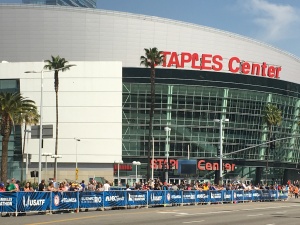 As Angelenos headed to happy hour to conclude their work weeks, many cheered and offered high fives as we ran by. While we were warned to be cautious of uneven the sidewalks, the most obvious obstacle didn’t have anything to do
As Angelenos headed to happy hour to conclude their work weeks, many cheered and offered high fives as we ran by. While we were warned to be cautious of uneven the sidewalks, the most obvious obstacle didn’t have anything to do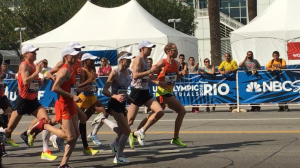 An hour before nearly 400 of the fastest U.S. marathoners would toe the line at the Olympic Trials, downtown LA’s Figueroa Street was eerily empty. A few who would be running Sunday’s LA Marathon were taking advantage of the barren roads for one last shakeout run. With anticipation building, I headed toward the start area to fully immerse myself in the festive atmosphere.
An hour before nearly 400 of the fastest U.S. marathoners would toe the line at the Olympic Trials, downtown LA’s Figueroa Street was eerily empty. A few who would be running Sunday’s LA Marathon were taking advantage of the barren roads for one last shakeout run. With anticipation building, I headed toward the start area to fully immerse myself in the festive atmosphere. Inside the Brooks cheer zone, I nestled myself up next to the fence that separated the area from the sidewalk. I imagine it was akin to standing backstage of the Grammy’s if one was an avid singer. Here, everyone seemed to have an equally close connection to the sport of running. Just an arms length away was Desi Linden’s father anxiously awaiting his daughter’s start. Hansons-Brooks Distance Project Coach Keith Hanson was there with his son, admitting that he was more nervous than Desi. A number of elite athlete coaches stopped to catch-up with others, sharing anecdotes about their athlete’s training progress. Ryan Hall bounded down the sidewalk to get in position to offer encouragement to his wife, Sara. If Eugene, Oregon was TrackTown, U.S.A., today this was MarathonTown, U.S.A.
Inside the Brooks cheer zone, I nestled myself up next to the fence that separated the area from the sidewalk. I imagine it was akin to standing backstage of the Grammy’s if one was an avid singer. Here, everyone seemed to have an equally close connection to the sport of running. Just an arms length away was Desi Linden’s father anxiously awaiting his daughter’s start. Hansons-Brooks Distance Project Coach Keith Hanson was there with his son, admitting that he was more nervous than Desi. A number of elite athlete coaches stopped to catch-up with others, sharing anecdotes about their athlete’s training progress. Ryan Hall bounded down the sidewalk to get in position to offer encouragement to his wife, Sara. If Eugene, Oregon was TrackTown, U.S.A., today this was MarathonTown, U.S.A. After watching much of the race from inside the Brooks cheer zone, I noticed some open space along the adjacent sidewalk, so I staked out a position alongside the “800M to go” signage. I was struck at how many spectators were there with a purpose, to cheer on their competing loved ones- nephews,cousins and the like. As the temperatures rose and many runners were visibly wearing, this family support was also making a visible impact – responding to the sound of a familiar voice, strides adjusted, parched lips curled and tightened faces momentarily relaxed.
After watching much of the race from inside the Brooks cheer zone, I noticed some open space along the adjacent sidewalk, so I staked out a position alongside the “800M to go” signage. I was struck at how many spectators were there with a purpose, to cheer on their competing loved ones- nephews,cousins and the like. As the temperatures rose and many runners were visibly wearing, this family support was also making a visible impact – responding to the sound of a familiar voice, strides adjusted, parched lips curled and tightened faces momentarily relaxed. If there was any doubt as to what a special sport this is, one needs only look to the back of the pack for inspiration. Granted, there’s something oxymoronic about referring to the back of the pack at the Olympic trials. Nonetheless, the crowd was acutely aware of the struggling runner at the back of the men’s race, and they responded with cheers of encouragement fitting for a frontrunner. As Kathrine Switzer once observed, “If you are losing faith in human nature, go out and watch a marathon.” On this day, the Road to Rio was certainly paved in spirit.
If there was any doubt as to what a special sport this is, one needs only look to the back of the pack for inspiration. Granted, there’s something oxymoronic about referring to the back of the pack at the Olympic trials. Nonetheless, the crowd was acutely aware of the struggling runner at the back of the men’s race, and they responded with cheers of encouragement fitting for a frontrunner. As Kathrine Switzer once observed, “If you are losing faith in human nature, go out and watch a marathon.” On this day, the Road to Rio was certainly paved in spirit.
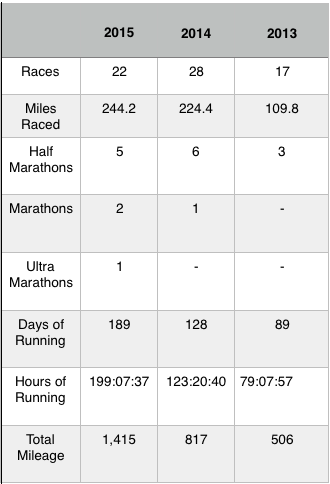
 When this year’s New York City marathon week kicked-off, I couldn’t help but stare at the calendar in disbelief that November was approaching so quickly. The 2015 event would be my second 5-borough trek and third marathon effort in twelve months.
When this year’s New York City marathon week kicked-off, I couldn’t help but stare at the calendar in disbelief that November was approaching so quickly. The 2015 event would be my second 5-borough trek and third marathon effort in twelve months. My pre-dawn journey to Staten Island could’ve inspired an apt sequel title for a sequel to an old 1980s Steve Martin and John Candy comedy. In this version, which I’d dubbed, “Trains, Ferries and Buses,” I was sure the odd couple would’ve found great comedic material from an underground ride in subway cars with marathoners wearing brightly colored shoe and clinging onto clear plastic starting village bags at one end, and disheveled party-goers still decked out in a random assortment of Halloween costumes at the other.
My pre-dawn journey to Staten Island could’ve inspired an apt sequel title for a sequel to an old 1980s Steve Martin and John Candy comedy. In this version, which I’d dubbed, “Trains, Ferries and Buses,” I was sure the odd couple would’ve found great comedic material from an underground ride in subway cars with marathoners wearing brightly colored shoe and clinging onto clear plastic starting village bags at one end, and disheveled party-goers still decked out in a random assortment of Halloween costumes at the other. Though I was wearing a throwaway hoodie and sweatpants over my shorts and tank top, these layers were largely unnecessary. It was a sharp contrast to when I entered the start village last year. Then, the gusty winds, at times in excess of 40 mph, were most unpleasant, and I still had mild case of PTSD from that epic struggle over the Verrazano. This year, the wind was nonexistent, and the temperatures were hovering near 60.
Though I was wearing a throwaway hoodie and sweatpants over my shorts and tank top, these layers were largely unnecessary. It was a sharp contrast to when I entered the start village last year. Then, the gusty winds, at times in excess of 40 mph, were most unpleasant, and I still had mild case of PTSD from that epic struggle over the Verrazano. This year, the wind was nonexistent, and the temperatures were hovering near 60. Following the up and down of the Verrazano Bridge and with Staten Island in the proverbial rear view mirror, I settled in for the long trek through Brooklyn. My primary goal for the day’s journey through New York’s most populous borough was to keep my pace around my target range, which my training plan had pinpointed to be between 8:22 and 8:35. As the miles ticked by, my Garmin showed I was holding relatively steady in the middle-to-upper range, though I knew that “officially” I was more likely slightly exceeding the upper portion of this range by a tad (after all, it’s impossible to run the tangents on such a congested course).
Following the up and down of the Verrazano Bridge and with Staten Island in the proverbial rear view mirror, I settled in for the long trek through Brooklyn. My primary goal for the day’s journey through New York’s most populous borough was to keep my pace around my target range, which my training plan had pinpointed to be between 8:22 and 8:35. As the miles ticked by, my Garmin showed I was holding relatively steady in the middle-to-upper range, though I knew that “officially” I was more likely slightly exceeding the upper portion of this range by a tad (after all, it’s impossible to run the tangents on such a congested course). When I walk outside my Upper East Side apartment and stand on the street corner, I have a clear view of the Queensboro bridge. But until last year’s New York City Marathon, I’d never run across it. The steady incline, which comes at mile 15, is often described as a long, lonely and quiet portion of the course, which adds a physical and mental challenge for marathoners before they’re jolted back to life by the thunderous crowds that will be waiting in Manhattan once they exit the bridge at mile 16. Since last year’s race, I’ve run over the Queensboro countless time as I logged training miles through all seasons. Its hills were a great addition to my regimen, and I’d actually looked forward to this segment of the course. Based on my year-over-year splits for the Queensboro Bridge miles, the training runs had certainly paid dividends- I’d managed to shave more than a minute off my pace this year.
When I walk outside my Upper East Side apartment and stand on the street corner, I have a clear view of the Queensboro bridge. But until last year’s New York City Marathon, I’d never run across it. The steady incline, which comes at mile 15, is often described as a long, lonely and quiet portion of the course, which adds a physical and mental challenge for marathoners before they’re jolted back to life by the thunderous crowds that will be waiting in Manhattan once they exit the bridge at mile 16. Since last year’s race, I’ve run over the Queensboro countless time as I logged training miles through all seasons. Its hills were a great addition to my regimen, and I’d actually looked forward to this segment of the course. Based on my year-over-year splits for the Queensboro Bridge miles, the training runs had certainly paid dividends- I’d managed to shave more than a minute off my pace this year. In the days leading up to marathon Sunday, I had watched the prospect of rain enter and leave the race day forecast. I’d also noticed the projected temperature range inch upward from the mid 50’s to the low-to-mid 60s. As one whose body temperature “runs hot,” I took issue with those forecasters describing the conditions as “ideal,” but wasn’t going to lose any sleep over it. In fact, I didn’t give it a second thought. After all, I’d completed any number of training runs, not to mention races in much warmer temperatures, albeit not a marathon. Why should this be any different?
In the days leading up to marathon Sunday, I had watched the prospect of rain enter and leave the race day forecast. I’d also noticed the projected temperature range inch upward from the mid 50’s to the low-to-mid 60s. As one whose body temperature “runs hot,” I took issue with those forecasters describing the conditions as “ideal,” but wasn’t going to lose any sleep over it. In fact, I didn’t give it a second thought. After all, I’d completed any number of training runs, not to mention races in much warmer temperatures, albeit not a marathon. Why should this be any different? Every runner’s body is different and responds to the surrounding environment differently. It seemed the 60 degree temperatures had been deceptively warmer than I’d anticipated. And while 60 degrees would have been just find for a half marathon, I was learning that, for me at least, the temperature’s impact on this day’s marathon distance was becoming very real.
Every runner’s body is different and responds to the surrounding environment differently. It seemed the 60 degree temperatures had been deceptively warmer than I’d anticipated. And while 60 degrees would have been just find for a half marathon, I was learning that, for me at least, the temperature’s impact on this day’s marathon distance was becoming very real.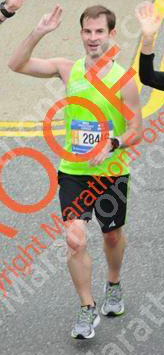 The final 5 miles were a chore. I had no choice but to slow down considerably, otherwise I’d of at best been sick, and at worst needed attention. I adopted a modified fartlek strategy in order to make it to the finish line in an upright position. I’d run, then slow when my body screamed for balance, and repeat. At aid stations I grabbed both gatorade and water, and focus on making it to the next station for more. It was a humbling experience.
The final 5 miles were a chore. I had no choice but to slow down considerably, otherwise I’d of at best been sick, and at worst needed attention. I adopted a modified fartlek strategy in order to make it to the finish line in an upright position. I’d run, then slow when my body screamed for balance, and repeat. At aid stations I grabbed both gatorade and water, and focus on making it to the next station for more. It was a humbling experience. When I mustered up enough courage to check my time I learned that, despite the rough final miles, I had managed a 3:55:37 finish. Though I was capable of better, I’d still completed the course nearly 5 minutes faster than last year!
When I mustered up enough courage to check my time I learned that, despite the rough final miles, I had managed a 3:55:37 finish. Though I was capable of better, I’d still completed the course nearly 5 minutes faster than last year!